death

 While riding the 1880 Train on the last day of our annual trip to the Black Hills, Bob and I were sitting back, relaxing and enjoying the ride. It is a favorite part of our trip each year. One of the things that I like to do on these train rides, is to listen to what the people around us think of the journey. When you ride the train every year. You know the area, and while it is still very interesting to me, I do know the area. Others don’t, so it’s interesting to see what they think of this area I love so much. I almost feel like a local listening to the tourists who are viewing this place for the first time.
While riding the 1880 Train on the last day of our annual trip to the Black Hills, Bob and I were sitting back, relaxing and enjoying the ride. It is a favorite part of our trip each year. One of the things that I like to do on these train rides, is to listen to what the people around us think of the journey. When you ride the train every year. You know the area, and while it is still very interesting to me, I do know the area. Others don’t, so it’s interesting to see what they think of this area I love so much. I almost feel like a local listening to the tourists who are viewing this place for the first time.
This trip’s most profound conversation was a little different, and it really made me think. The train has a recorded narrative, and a little boy, about 5 or 6 years old was listening to it. So often, children don’t really listen to such things, but this little boy was rather intently listening to the message. So as he listened, the narrator said that 
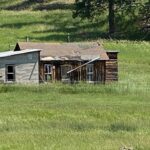 the train was in use during World War I and World War II, and the boy said, “What’s a war?” That really made me wonder…how nice it would be, not to know what war is. Yes, there have been wars in his lifetime, and indeed, we are in one even now, but this little boy is too young to really fathom the meaning of the word…war. He still possessed an innocence when it comes to war, killing, and death. That innocence is about to end, I suppose, because once his aunt or mother answered his question, he will forever know what a war is. He cannot go back to that innocence again. It is gone.
the train was in use during World War I and World War II, and the boy said, “What’s a war?” That really made me wonder…how nice it would be, not to know what war is. Yes, there have been wars in his lifetime, and indeed, we are in one even now, but this little boy is too young to really fathom the meaning of the word…war. He still possessed an innocence when it comes to war, killing, and death. That innocence is about to end, I suppose, because once his aunt or mother answered his question, he will forever know what a war is. He cannot go back to that innocence again. It is gone.
I came away from that experience a little sad. Children have such an innocent joy, and for this boy, that is changing. True…he won’t fully lose that innocence in one explanation, and it will depend on how much the 
 adults with him can soften the truth for him, but no matter what we do or say, war and death go together, and death by war is not pretty. This boy has an imagination, and if he continues to question the adults in his life, he will begin to get a clear picture of war, and what it really is. Then, as he grows, that picture will become more and more vivid. He will know what death by war means. War is a part of life, and eventually we all know what war means, but for me, the question felt sad, because I was witnessing the beginning of the end of his innocence. It’s a moment I wont easily forget either.
adults with him can soften the truth for him, but no matter what we do or say, war and death go together, and death by war is not pretty. This boy has an imagination, and if he continues to question the adults in his life, he will begin to get a clear picture of war, and what it really is. Then, as he grows, that picture will become more and more vivid. He will know what death by war means. War is a part of life, and eventually we all know what war means, but for me, the question felt sad, because I was witnessing the beginning of the end of his innocence. It’s a moment I wont easily forget either.
 I have never been caught up in a serious earthquake, and I don’t think I want to, but stories of survival in an earthquake, are always filled with hope. Earthquakes remain the one natural disaster that the scientists can’t successfully predict. They may make the attempt, but any earthquake that comes on or near the date predicted, is coincidental. They might come close one time, but totally miss it the next. Earthquakes simply confound the scientists. The Avezzano Earthquake near Avezzano, Italy was no exception.
I have never been caught up in a serious earthquake, and I don’t think I want to, but stories of survival in an earthquake, are always filled with hope. Earthquakes remain the one natural disaster that the scientists can’t successfully predict. They may make the attempt, but any earthquake that comes on or near the date predicted, is coincidental. They might come close one time, but totally miss it the next. Earthquakes simply confound the scientists. The Avezzano Earthquake near Avezzano, Italy was no exception.
At 7:49am on January 13, 1915, the people in the Marsica area, a suburb of Avezzano, were going about their day…business as usual, but at 7:50am everything changed. It was a clear, cold morning, after a hard winter night during which the Northern wind blew through the area with a display of crazy violence from dusk until dawn. One survivor had been running errands, and when he came back, he found his brother and cousin sitting by the 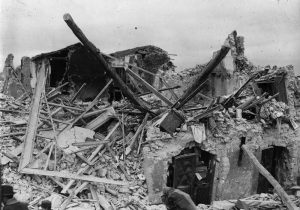 fireplace, while his mother was busy preparing milk and coffee for her two boys. The younger brother would be heading to school after breakfast, but 15 minutes later at 7:50am, the earth started to rumble around them.
fireplace, while his mother was busy preparing milk and coffee for her two boys. The younger brother would be heading to school after breakfast, but 15 minutes later at 7:50am, the earth started to rumble around them.
It didn’t matter that it was 1915, because there are no warning systems for earthquakes in this day and age either. The only thing that might have made a difference would have been buildings that were more earthquake proof. Still, it seems that deaths during earthquakes can happen even if the buildings are earthquake proof. The magnitude 6.7 earthquake destroyed the city. Often we think of an earthquake that brings that much destruction being of far greater magnitude than a 6.7 and maybe the stability of the buildings was the problem. People woke up with debris on them, finding it hard to breathe. Families were ripped apart. Some 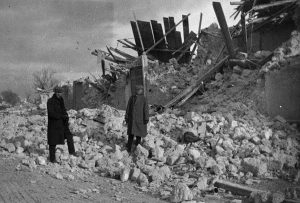 lived and some died. The city and the surrounding area was in mourning.
lived and some died. The city and the surrounding area was in mourning.
When the people came outside, a terrifying sight greeted them. There was a huge greyish cloud that was hanging over the suburbs. The city below the cloud was flattened. The air was filled with the acrid smell of old plaster, and the screams and cries of people who were trapped or had found their loved ones deceased. The city was in despair. Death was everywhere. Beloved, historic buildings were gone…many of which had been thought to be indestructible. The total loss of life in the 1915 Avezzano earthquake was 30,000 people. The financial loss was $60 million.
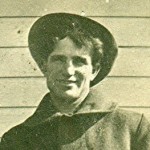
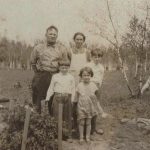 I never had the opportunity to get to know my Grandpa Allen Luther Spencer, because he passed away before my parents were married, and 4½ years before I was born. Life was not always easy for my grandfather. His first marriage ended in divorce, following the death of his daughter, Dorothy, which was quickly followed by the birth of his son, Norman. The loss of a child can be so devastating, that many people never recover, and many marriages fail. It was a dark time for him, until he met my grandmother.
I never had the opportunity to get to know my Grandpa Allen Luther Spencer, because he passed away before my parents were married, and 4½ years before I was born. Life was not always easy for my grandfather. His first marriage ended in divorce, following the death of his daughter, Dorothy, which was quickly followed by the birth of his son, Norman. The loss of a child can be so devastating, that many people never recover, and many marriages fail. It was a dark time for him, until he met my grandmother.
After their marriage and four more children, Laura in 1912, Bill in 1922, Allen (my dad) in 1924, and Ruth in 1925, it looked like his life was on the right track again. Of course, like many other people, this good period was followed by the Great Depression. Thankfully, my grandfather was a carpenter (mostly for the Great Northern Railway), and as near as I can tell, had a job throughout the Great Depression. Still, times were tough, and I’m sure the wages were not what a family of six really needed to live. Most people struggled during the Great Depression.
My grandfather was a product of his circumstances, and the times he lived in, and the two things together created a stressful life for him and his second family. Much more was expected of the two older children, and feelings were raw at times. The younger two children really never remember his being so hard on them. Grandpa had specific ideas of things the children should learn and do. All of the children learned to play the violin and some learned the guitar. My Aunt Laura never really liked learning to play the violin, but the rest of the children did…or at least they did later. Grandpa Spencer may not have been an easy teacher, or maybe it’s just hard to learn from your dad.
No matter what kind of a man my grandfather was, and whether circumstances led to his troubles, his children loved him very much. Like any family, kids and parents “lock horns” sometimes. That doesn’t mean you don’t love them. When my grandfather was dying, my dad drove from Casper, Wyoming to Superior, Wisconsin, 980 
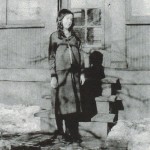 miles, in 17 hours. That might not seem like a big deal these days, but cars didn’t do what they can do now, and speeds were different then too. Needless to say, my dad made it home to see his dad before he passed away, and he was always thankful that he made the trip, and always thankful that he saw his dad one more time. I only wish I could have met him and gotten to know him too. I feel like I missed out, on my grandfather and my Grandma Spencer, who passed away when I was 2½ months old. Happy birthday in Heaven Grandpa Spencer. I look forward to meeting you someday soon.
miles, in 17 hours. That might not seem like a big deal these days, but cars didn’t do what they can do now, and speeds were different then too. Needless to say, my dad made it home to see his dad before he passed away, and he was always thankful that he made the trip, and always thankful that he saw his dad one more time. I only wish I could have met him and gotten to know him too. I feel like I missed out, on my grandfather and my Grandma Spencer, who passed away when I was 2½ months old. Happy birthday in Heaven Grandpa Spencer. I look forward to meeting you someday soon.
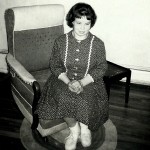
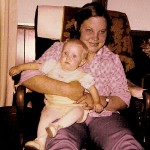 I have four sisters, and three brothers-in-law. My husband Bob had four sisters and one brother. He still has three sisters, his brother, a sister-in-law, and two brothers-in-law. We are missing his sister, Marlyce, who died of cancer on August 13, 1989 at just 39 years old. Marlyce was the first sibling death any of us had experienced, and it left a large hole in our lives. It just seemed impossible, like a horrible nightmare. How could our sweet Marlyce be gone? I suppose that disbelief at her passing, showed the innocence we all had about life, even though we weren’t seriously young. There are just people you don’t expect to lose…at least not until much later in life, and siblings definitely fall into that category. When Marlyce passed away, she took with her a portion of the joy the family had always had. She was always so sweet, and filled with a desire to help others, and make people happy.
I have four sisters, and three brothers-in-law. My husband Bob had four sisters and one brother. He still has three sisters, his brother, a sister-in-law, and two brothers-in-law. We are missing his sister, Marlyce, who died of cancer on August 13, 1989 at just 39 years old. Marlyce was the first sibling death any of us had experienced, and it left a large hole in our lives. It just seemed impossible, like a horrible nightmare. How could our sweet Marlyce be gone? I suppose that disbelief at her passing, showed the innocence we all had about life, even though we weren’t seriously young. There are just people you don’t expect to lose…at least not until much later in life, and siblings definitely fall into that category. When Marlyce passed away, she took with her a portion of the joy the family had always had. She was always so sweet, and filled with a desire to help others, and make people happy.
One of the greatest events in Marlyce’s life was the day she became an aunt. She always loved babies, and each new niece or nephew was a treasure. Of all the nieces and nephews, there was only one she did not get to meet, Eric Parmely. And of course, she never got to meet all the grand nieces and grand nephews, or her great grand niece…sadly, because she would have loved every one of them. Marlyce’s developmental disabilities didn’t keep her from being able to hold the babies, and play with the little ones. She loved them as if they were her own babies. I suppose that if her circumstances had been different, maybe she could have been a mom, but that was not to be.
Marlyce went to Wood’s School as a child. Wood’s was a school for the developmentally disabled back then. These days the school district tries to incorporate these students into the public school system. I like that, whenever it is possible, but Marlyce had a great education anyway, and then they helped her to find a job. Marlyce worked several places, and always liked going to work. She never wanted to miss work…not for illness, 
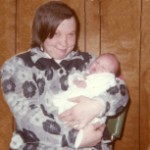 holidays, or vacations…except maybe Christmas. Marlyce loved being needed. Baking cookies, holding babies, working, and knitting were things that made her feel useful. What she never knew was that she was so much more than those things to us. We would have loved her even if she couldn’t make things, work, or even hold the babies. Marlyce holds a special place in our hearts, and she always will. Today would have been Marlyce’s 69th birthday. I can’t believe that she has been gone almost 30 years now, but I miss her like it was yesterday. Happy birthday in Heaven, Marlyce. We love and miss you.
holidays, or vacations…except maybe Christmas. Marlyce loved being needed. Baking cookies, holding babies, working, and knitting were things that made her feel useful. What she never knew was that she was so much more than those things to us. We would have loved her even if she couldn’t make things, work, or even hold the babies. Marlyce holds a special place in our hearts, and she always will. Today would have been Marlyce’s 69th birthday. I can’t believe that she has been gone almost 30 years now, but I miss her like it was yesterday. Happy birthday in Heaven, Marlyce. We love and miss you.
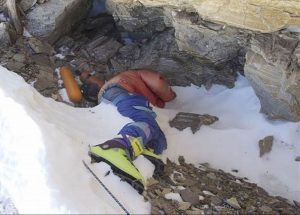 I love to hike, but that does not include going to the highest peak I can find. Don’t get me wrong, because I have hiked to the top of some mountains. They just weren’t on the level of Everest or K2. While I love to challenge myself by hiking up some pretty big mountains, I’m just not interested in taking on the ones where the air is so thin that you need oxygen, and the snow never melts. There are, nevertheless, people who feel the challenge to ascend to the highest peaks in the world. They throw caution to the wind, to go where few people have ever gone before. Believe me, I admire their tenacity, but that is simply not a goal I have, or ever will set, for myself.
I love to hike, but that does not include going to the highest peak I can find. Don’t get me wrong, because I have hiked to the top of some mountains. They just weren’t on the level of Everest or K2. While I love to challenge myself by hiking up some pretty big mountains, I’m just not interested in taking on the ones where the air is so thin that you need oxygen, and the snow never melts. There are, nevertheless, people who feel the challenge to ascend to the highest peaks in the world. They throw caution to the wind, to go where few people have ever gone before. Believe me, I admire their tenacity, but that is simply not a goal I have, or ever will set, for myself.
Mount Everest is a very unforgiving mountain. In the years that people have been climbing it, there have been over 200 deaths on it slopes. These were experienced climbers who knew what they were up against, and yet, the elements and the lack of breathable oxygen, beat them in the end. Of those 200+ people who lost their lives to Everest, many are still up on the slopes, right where they fell. They didn’t get off the beaten paths, they just didn’t get back down quickly enough, and now their bodies serve as a grim reminder of the harsh reality that is Everest. These people might have truly believed that they could make it, and many of them had no idea that they were dying. Severe cold and lack of oxygen will do that to a person.
In a gruesome ritual, each new climber who takes the challenge and starts up the mountain, must pass by the unfortunate ones who didn’t make it back down. To me, the bodies would serve as a warning to turn around and go back down, now…to use my head and stay alive, rather than my ambition to succeed at something that, to most of us, seems insane. I know that there are people who would disagree, believing that challenge is worth the risk, and it might be, right up to the point when you realize that you are about to become a statistic of Mount Everest. Of course, by the time you realize that, it is too late.
Mount Everest, located some 186 miles north-east of Kathmandu, holds the impressive title of tallest mountain in the world, but many people don’t know about its other, more gruesome title…the world’s largest open-air graveyard. Edmund Hillary and Tenzing Norgay first scaled the summit in 1953. Since then, over 4,000 people have followed in their footsteps, braving the harsh climate and dangerous terrain in the hope of a few moments of glory. Unfortunately, some of them never left the mountain. The top portion of the mountain, roughly everything above 26,000 feet, is known as the “death zone.” In the “death zone” the oxygen levels are only at a third of what they are at sea level, and the barometric pressure causes weight to feel ten times heavier. The combination of those two factors makes climbers feel sluggish, disoriented and fatigued…and can cause extreme stress on organs. For this reason, climbers don’t usually last more than 48 hours in this area.
The climbers that overstay their safety window are usually left with lasting effects. The ones that don’t make it out are left where they fall…it’s standard protocol, unfortunately, and so these corpses remain to spend eternity on the mountaintop, serving as a warning to climbers as well as gruesome mile markers. Each climber who attempts Mount Everest knows the possibilities. One of the most famous corpses, known as “Green Boots” was passed by almost every climber to reach the death zone. The identity of Green Boots while highly contested, is believed to be Tsewang Paljor, an Indian climber who died in 1996. Before the body’s recent removal, Green Boot’s body rested near a cave that all climbers must pass on their way to the peak. The body became a grim landmark used to gauge how close one is to the summit. He is famous for his green boots. According to one seasoned adventurer “about 80% of people also take a rest at the shelter where Green Boots is, and it’s hard  to miss the person lying there.” “Green Boots” is known as such because of the neon boots he was wearing when he died.
to miss the person lying there.” “Green Boots” is known as such because of the neon boots he was wearing when he died.
In 2006 another climber joined in Green Boots in his cave, sitting, arms around his knees in the corner, forever. David Sharp was attempting to summit Everest on his own, which is never advisable. Even the most advanced climbers would warn against it. He had stopped to rest in Green Boots’ cave, as so many had done before him. Over the course of several hours, he froze to death, his body stuck in a huddled position, just feet from one of the most famous Mount Everest bodies. Green Boots most likely died unnoticed, due to the small amount of people hiking at that time, but at least 40 people passed by Sharp that day. Incredibly, not one of them stopped. Sharpe’s death sparked a moral debate about the culture of Everest climbers. Though many had passed by Sharp as he lay dying, and their eyewitness accounts claim he was visibly alive and in distress, no one offered their help. How could they even live with themselves after that?
Sir Edmund Hillary, the first man to ever summit the mountain, criticized the climbers who had passed by Sharp and attributed it to the mind-numbing desire to reach the top. “If you have someone who is in great need and you are still strong and energetic, then you have a duty, really, to give all you can to get the man down and getting to the summit becomes very secondary,” he told the New Zealand Herald, after news of Sharp’s death broke. “I think the whole attitude towards climbing Mount Everest has become rather horrifying,” he added. “The people just want to get to the top. They don’t give a damn for anybody else who may be in distress and it doesn’t impress me at all that they leave someone lying under a rock to die.” The media termed this phenomenon “summit fever,” and it’s happened more times than most people realize.
In 1999, the oldest known body was found on Everest. George Mallory’s body was found 75 years after his 1924 death after an unusually warm spring. Mallory had attempted to be the first person to climb Everest, though he had disappeared before it could be found out if he had achieved his goal.
His body was found in 1999, his upper torso, half of his legs, and his left arm almost perfectly preserved. He was dressed in a tweed suit and surrounded by primitive climbing equipment and heavy oxygen bottles. He had a rope injury around his waist, which led those who found him to believe he had been roped to another climber when he fell from the side of a cliff. The fate of the other climber is unknown, and no one knows if Mallory made it to the top, so the title of “the first man to climb Everest” was given to someone else. Though he may not have made it, rumors of Mallory’s climb had swirled for years, leading many to wonder. He was a famous mountaineer at the time and when asked why he wanted to climb the then unconquered mountain, he famously replied, “Because it’s there.”
One of the most horrifying sights on Mount Everest is the body of Hannelore Schmatz. In 1979, Schmatz became not only the first German citizen to perish on the mountain but also the first woman. Schmatz had actually reached her goal of summiting the mountain, before ultimately succumbing to exhaustion on the way down. Her Sherpa’s warned her not to set up camp in the “death zone,” but she did anyway. She managed to survive a snowstorm hitting overnight, and made it almost the rest of the way down to camp before a lack of oxygen and frostbite resulted in her giving into exhaustion. This poor woman fell just 330 feet from base camp. That is a devastating loss…so close and yet too far. Her body remains on the mountain, extremely well preserved due to the consistently below zero temperatures. For a long time, her body remained in plain view of the mountain’s Southern Route, leaning against a long deteriorated backpack with her eyes open and her hair blowing in the wind. Then, 70-80 mph winds either blew a covering of snow over her or pushed her off the mountain. Her final resting place is currently unknown.
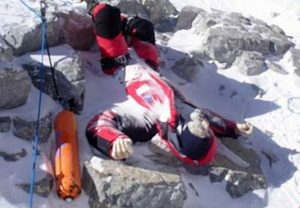 It’s due to the same things that kill these climbers that recovery of their bodies can’t take place. To us that seems insane, but when someone dies on Everest, especially in the death zone, it is almost impossible to retrieve the body. The weather conditions, the terrain, and the lack of oxygen makes it difficult to get to the bodies. Even if they can be found, they are usually stuck to the ground, frozen in place. In fact, two rescuers died while trying to recover Schmatz’s body and countless others have perished while trying to reach the rest. Despite those risks, and the bodies they know they will encounter, thousands of people still flock to Everest every year to attempt one of the most impressive, if not insane, feats known to man today.
It’s due to the same things that kill these climbers that recovery of their bodies can’t take place. To us that seems insane, but when someone dies on Everest, especially in the death zone, it is almost impossible to retrieve the body. The weather conditions, the terrain, and the lack of oxygen makes it difficult to get to the bodies. Even if they can be found, they are usually stuck to the ground, frozen in place. In fact, two rescuers died while trying to recover Schmatz’s body and countless others have perished while trying to reach the rest. Despite those risks, and the bodies they know they will encounter, thousands of people still flock to Everest every year to attempt one of the most impressive, if not insane, feats known to man today.

 Louis Mantin, was a French aesthete, which is a person who has a special appreciation of art and beauty. He was also, “obsessed with death and the passage of time.” He wrote in his will that he wanted to turn his home into a museum after his death. He wanted to share his love of art, and his vast collection with others. However, his Will was very explicit in the details of how this would be carried out, and some might even say it was eccentric. In his will, he made a very specific and seemingly odd request, the museum would open 100 years after his passing.
Louis Mantin, was a French aesthete, which is a person who has a special appreciation of art and beauty. He was also, “obsessed with death and the passage of time.” He wrote in his will that he wanted to turn his home into a museum after his death. He wanted to share his love of art, and his vast collection with others. However, his Will was very explicit in the details of how this would be carried out, and some might even say it was eccentric. In his will, he made a very specific and seemingly odd request, the museum would open 100 years after his passing.
Mantin died in 1905, and though he made it very clear in his will what he wanted the house to be in 100 years, he didn’t make any provisions for the upkeep of the house in the meantime. Because nothing was specifically laid out, the house eventually fell into disrepair, because it was locked up and ignored. Eventually, worms and mold settled in among his statues and in the elaborate wallpaper. After a distant relative discovered Mantin’s will and initiated an extensive renovation project, the house was finally re-opened as a museum in 2010. It was five years late, but the will was finally carried out. I suppose that it took a little time to get the house back into a condition that would allow the house to become a museum.
Townspeople and tourists can now marvel at this once hidden world, that went completely untouched for a century, admiring Mantin’s eclectic collections, as well as his flushing toilet and heated floors, true luxuries for any home back in 1905. Mantin inherited a large fortune from his father, and since he was a bachelor, with no children, he used the money to start collecting the things that he loved. He was almost obsessive about it. 
 Egyptian relics, medieval locks and keys, monkey skulls, and stuffed blowfish. Mantin had strange taste, and since he inherited the money later in life, he knew that his time with his newly acquired collection would be short. He decided that the logical solution was to turn his home into a museum. He thought people might like to know how an artistic gentleman had lived at the turn of the century. The museum might be filled with odd relics, but when you consider how rare they are, their value in the world of art would probably make them priceless.
Egyptian relics, medieval locks and keys, monkey skulls, and stuffed blowfish. Mantin had strange taste, and since he inherited the money later in life, he knew that his time with his newly acquired collection would be short. He decided that the logical solution was to turn his home into a museum. He thought people might like to know how an artistic gentleman had lived at the turn of the century. The museum might be filled with odd relics, but when you consider how rare they are, their value in the world of art would probably make them priceless.
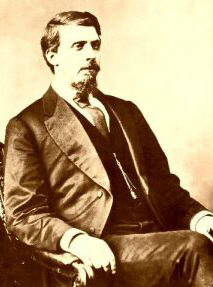 The Indian Territory, which is now Oklahoma, in 1875, was populated by cattle and horse thieves, whiskey peddlers, and bandits who sought refuge in the untamed territory that was free of a “White Man’s Court.” There was one court with jurisdiction over Indian Territory was the U.S. Court for the Western District of Arkansas located in Fort Smith, Arkansas, which was situated on the border of Western Arkansas and Indian Territory. Judge Isaac Parker, who was often called the “Hanging Judge,” from Fort Smith, Arkansas ruled over the lawless land of Indian Territory in the late 1800s. He was determined to stop the pollution of the Indian Territory that was the outlaws who thought they could outrun the law.
The Indian Territory, which is now Oklahoma, in 1875, was populated by cattle and horse thieves, whiskey peddlers, and bandits who sought refuge in the untamed territory that was free of a “White Man’s Court.” There was one court with jurisdiction over Indian Territory was the U.S. Court for the Western District of Arkansas located in Fort Smith, Arkansas, which was situated on the border of Western Arkansas and Indian Territory. Judge Isaac Parker, who was often called the “Hanging Judge,” from Fort Smith, Arkansas ruled over the lawless land of Indian Territory in the late 1800s. He was determined to stop the pollution of the Indian Territory that was the outlaws who thought they could outrun the law.
Judge Isaac Parker was born in a log cabin outside Barnesville, Belmont County, Ohio on October 15, 1838. The youngest son of Joseph and Jane Parker. As a boy, Isaac helped out on the farm, but never really cared for that type of work. He attended the Breeze hill primary school and then the Barnesville Classical Institute. Knowing he wanted more, he decided to go for a higher education. To help pay for it, he taught students in a country primary school. When he was 17 he decided to study law, his legal training consisting of a combination of apprenticeship and self study. Reading law with a Barnesville attorney, he passed the Ohio bar exam in 1859 at the age of 21. During this period of his life, he met and married Mary O’Toole and the couple had two sons, Charles and James. Over the years, Parker built a reputation for being an honest lawyer and a much respected leader of the community.
After Parker passed the bar, he decided to head west, ending up in Saint Joseph, Missouri a bustling Missouri River port town. He went to work for his uncle, D.E. Shannon, becoming a partner in the Shannon and Branch legal firm. By 1861, he was working on his own in both the municipal and county criminal courts. In April of 1861, he won the election as City Attorney. He was re-elected to the post for the next two years. In 1864, 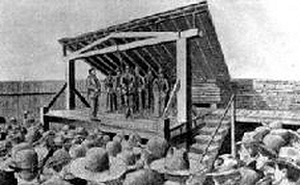 Isaac Parker ran for county prosecutor of the Ninth Missouri Judicial District and in the fall of that same year, he served as a member of the Electoral College, casting his vote for Abraham Lincoln. During a political career that included a six-year term as judge of the Twelfth Missouri Circuit in 1868, Parker would soon gain the experience that he would later use as the ruling Judge over the Indian Territory.
Isaac Parker ran for county prosecutor of the Ninth Missouri Judicial District and in the fall of that same year, he served as a member of the Electoral College, casting his vote for Abraham Lincoln. During a political career that included a six-year term as judge of the Twelfth Missouri Circuit in 1868, Parker would soon gain the experience that he would later use as the ruling Judge over the Indian Territory.
After the Civil War, the number of outlaws had grown, wrecking the relative peace of the five civilized tribes that lived in Indian Territory. By the time Parker arrived at Fort Smith, the Indian Territory had become known as a very bad place, where outlaws thought the laws did not apply to them and terror reigned. Parker replaced Judge William Story, whose tenure had been marred by corruption, after arriving in Fort Smith on May 4, 1875. At the age of 36, Judge Parker was the youngest Federal judge in the West. Holding court for the first time on May 10, 1875, eight men were found guilty of murder and sentenced to death. Judge Parker held court six days a week, often up to ten hours each day and tried 91 defendants in his first eight weeks on the bench. He was determined to clean up the Indian Territory, single handedly if necessary. In that first summer, eighteen persons came before him charged with murder and 15 were convicted. Eight of them were sentenced to die on the gallows on September 3, 1875. However, only six would be executed as one was killed trying to escape and a second had his sentence commuted to life in prison because of his young age.
The day of the September 3, 1875 hanging was a media circus, and because of all the attention, everyone knew that the once corrupt court was functioning properly again. Parker’s critics dubbed him the “Hanging Judge” and called his court the “Court of the Damned.” They thought Judge Parker was too harsh. The Fort  Smith Independent was the first newspaper to report the event on September 3, 1875 with the large column heading reading: “Execution Day!!” Other newspapers around the country reported the event a day later. These press reports shocked people throughout the nation. “Cool Destruction of Six Human Lives by Legal Process” screamed the headlines. Of the six felons, three were white, two were Native American and one was black. When the preliminaries were over, the six were lined up on the scaffold while executioner George Maledon adjusted the nooses around their necks. The trap was sprung all six died at once at the end of the ropes. The event solidified Judge Parker’s nickname for all time. In 21 years on the bench, Judge Parker tried 13,490 cases, 344 of which were capital crimes. 9,454 cases resulted in guilty pleas or convictions. Over the years, Judge Parker sentenced 160 men to death by hanging, though only 79 of them were actually hanged. The rest died in jail, appealed or were pardoned. Judge Parker died on November 17, 1896.
Smith Independent was the first newspaper to report the event on September 3, 1875 with the large column heading reading: “Execution Day!!” Other newspapers around the country reported the event a day later. These press reports shocked people throughout the nation. “Cool Destruction of Six Human Lives by Legal Process” screamed the headlines. Of the six felons, three were white, two were Native American and one was black. When the preliminaries were over, the six were lined up on the scaffold while executioner George Maledon adjusted the nooses around their necks. The trap was sprung all six died at once at the end of the ropes. The event solidified Judge Parker’s nickname for all time. In 21 years on the bench, Judge Parker tried 13,490 cases, 344 of which were capital crimes. 9,454 cases resulted in guilty pleas or convictions. Over the years, Judge Parker sentenced 160 men to death by hanging, though only 79 of them were actually hanged. The rest died in jail, appealed or were pardoned. Judge Parker died on November 17, 1896.
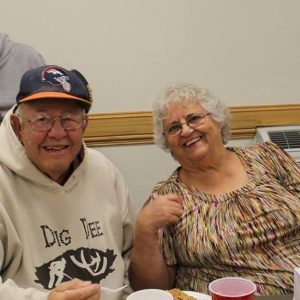 My uncle, Jim Richards lost his dad when he was a young not of just eight years. The death of a loved one affects each of us differently, as does the age we are, the age of the decedent, and the circumstances of the death. Some people decide that they were robbed, and end up living the rest of their lives in anger. Others decide that our lives are what we make of them, and there are still people who love us and need us around. For Uncle Jim, the decision was easy. He was the type of person to be there for others. I suppose that many people would think that a life of service would never be what they would want, but Uncle Jim didn’t have to think twice. He knew that he would never leave anyone to go it alone. He would be there, beginning with his mom.
My uncle, Jim Richards lost his dad when he was a young not of just eight years. The death of a loved one affects each of us differently, as does the age we are, the age of the decedent, and the circumstances of the death. Some people decide that they were robbed, and end up living the rest of their lives in anger. Others decide that our lives are what we make of them, and there are still people who love us and need us around. For Uncle Jim, the decision was easy. He was the type of person to be there for others. I suppose that many people would think that a life of service would never be what they would want, but Uncle Jim didn’t have to think twice. He knew that he would never leave anyone to go it alone. He would be there, beginning with his mom.
As a dad, Uncle Jim all about his family. They lived on a little place east of Casper for as long as I can remember, and I remember going out there and thinking what a cool place it was. I had never lived in the country, and I thought it was very cool. As an adult, my husband, Bob and I lived in the the country too. I thought about Uncle Jim and Aunt Dixie’s place many times, and thought it was amazing that I lived in the country too, because it never occurred to me that I would when I was a kid.
Life didn’t change Uncle Jim either. He found that he had a heart for helping people. that heart for helping would follow Uncle Jim all his life. His family was his life, both his own family, and his mom and siblings. They  always knew that they could count on him, and he never let them down. They were a close, loving family, and his wife and children loved him very much. He helped his family many times over the years, and they were grateful, but it was when his grandchildren arrived that Uncle Jim really had the opportunity to help out, and it was one of the things that endeared him to his children forever. He and Aunt Dixie took care of the grandchildren while their parents worked. They didn’t need daycare. Such a blessing. they ran the kids to and from school when needed, and that was a great blessing. Uncle Jim’s has been a life of service to others, and and that is such an honorable thing to do.Today is Uncle Jim’s birthday. Happy birthday Uncle Jim!! Have a great day!! We love you!
always knew that they could count on him, and he never let them down. They were a close, loving family, and his wife and children loved him very much. He helped his family many times over the years, and they were grateful, but it was when his grandchildren arrived that Uncle Jim really had the opportunity to help out, and it was one of the things that endeared him to his children forever. He and Aunt Dixie took care of the grandchildren while their parents worked. They didn’t need daycare. Such a blessing. they ran the kids to and from school when needed, and that was a great blessing. Uncle Jim’s has been a life of service to others, and and that is such an honorable thing to do.Today is Uncle Jim’s birthday. Happy birthday Uncle Jim!! Have a great day!! We love you!
 I saw picture of the New York skyline that was taken on September 10, 2001, about 24 hours before the attacks on the World Trade Center on September 11, 2001. It was profound. The picture, taken so innocently, probably by a tourist, foretold nothing of the horror that was eminent. No one knew. No one suspected. No one thought such an attack could ever happen on American soil again, but it did, and just 24 hours after this picture was taken, we would all know that it definitely could, and did happen here again.
I saw picture of the New York skyline that was taken on September 10, 2001, about 24 hours before the attacks on the World Trade Center on September 11, 2001. It was profound. The picture, taken so innocently, probably by a tourist, foretold nothing of the horror that was eminent. No one knew. No one suspected. No one thought such an attack could ever happen on American soil again, but it did, and just 24 hours after this picture was taken, we would all know that it definitely could, and did happen here again.
Just 24 hours after this picture was taken, the lives of 2,996 people would be over (including the 19 hijackers). In addition, more than 6,000 people would be injured. These immediate deaths included 265 on the four planes (including the terrorists), 2,606 in the World Trade Center and in the surrounding area, and 125 at the Pentagon. The September 11th attacks were the deadliest terrorist attack in world history, and the most devastating foreign attack on United States soil since the attack on Pearl Harbor on December 7, 1941…the last time we had thought it could never happen here.
We could go over the deaths of the people here, but we all know the horror that took place. We wanted to close our eyes to the terrible images, and yet, in utter disbelief, we could not look away. We hoped against hope, and prayed without ceasing, that by some miracle, more people would be found alive. Still, as time went on, we knew there would be no more survivors. Nevertheless, we waited and we watched. We watched with hope, but we also watched with anger. There was no reason for such a horrible attack on our nation. We weren’t at war, and we had done nothing to hurt these attackers. Yet, somehow, in their twisted, evil minds, we had. And they reveled in the way that they had managed to secretly pull this attack off.
Now, 17 years later, with so many of our young adults almost unaware of the attacks of September 11, 2001, 
 we find ourselves in a place where many people think it could never happen here again, and yet, our world is actually more dangerous now than it was then. We must always be alert. We must never forget those attacks. Never assume that evil will leave our nation alone, if we try to be nice to it. Appeasement only makes us look vulnerable, and that opens the door to attack. It has been proven time and time again. Just like the picture of the New York skyline on September 10, 2001 seemed so serene, it held a dark secret that would only be revealed in the stark daylight of September 11.
we find ourselves in a place where many people think it could never happen here again, and yet, our world is actually more dangerous now than it was then. We must always be alert. We must never forget those attacks. Never assume that evil will leave our nation alone, if we try to be nice to it. Appeasement only makes us look vulnerable, and that opens the door to attack. It has been proven time and time again. Just like the picture of the New York skyline on September 10, 2001 seemed so serene, it held a dark secret that would only be revealed in the stark daylight of September 11.
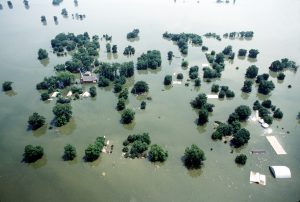 For many years, levee systems were built along rivers to hold back flood waters. They work very well…until they don’t. When a levee ruptures, the resulting flood is usually devastating. From June through August of 1993, the midwestern United States received an unusually large amount of rain…far more than normal. The rain led to severe flooding, particularly along the Illinois and Missouri shores. Then, on July 22, 1993, the levee holding back the flooding Mississippi River at Kaskaskia, Illinois, ruptured. The town’s people were forced to flee on barges. In all, more than 1,000 levees burst in late July, but, the incident at Kaskaskia was the most dramatic event of the flood. The town, which was virtually an island, was protected by a levee that the town attempted to shore up even after the bridge connecting the town to the riverside was wiped out by the rising river. At
For many years, levee systems were built along rivers to hold back flood waters. They work very well…until they don’t. When a levee ruptures, the resulting flood is usually devastating. From June through August of 1993, the midwestern United States received an unusually large amount of rain…far more than normal. The rain led to severe flooding, particularly along the Illinois and Missouri shores. Then, on July 22, 1993, the levee holding back the flooding Mississippi River at Kaskaskia, Illinois, ruptured. The town’s people were forced to flee on barges. In all, more than 1,000 levees burst in late July, but, the incident at Kaskaskia was the most dramatic event of the flood. The town, which was virtually an island, was protected by a levee that the town attempted to shore up even after the bridge connecting the town to the riverside was wiped out by the rising river. At  9:48am, the levee broke, leaving the people of Kaskaskia with no escape route other than two Army Corp of Engineers barges. By 2pm, the entire town was underwater.
9:48am, the levee broke, leaving the people of Kaskaskia with no escape route other than two Army Corp of Engineers barges. By 2pm, the entire town was underwater.
The rupture of the levee at Quincy, Illinois, left no way to cross the Mississippi River for 250 miles north of Saint Louis. In Grafton, Illinois, flood waters reached two stories high. Other towns fared somewhat better, but the flooding was bad everywhere. In Saint Genevieve, Missouri, the entire town turned out in a desperate attempt to raise the levee. Prisoners were even brought in to assist the effort. The river crested at a record 49 feet, just two feet below the improved levee. The flood inundated 1 million acres of prime farm land and wreaked havoc on the area’s economy. Miles of wheat fields were too saturated to harvest that season. In addition, the herbicides from the farms washed down the river and severely damaged fish farms in Louisiana. Many other people lost their jobs when barge traffic on the river was suspended for two months. The Mississippi 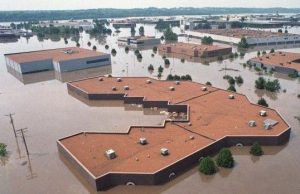 flood of 1993 caused $18 billion in damages and killed 52 people.
flood of 1993 caused $18 billion in damages and killed 52 people.
Levees can save lives, but when levees fail…people die, and property is destroyed. Sometimes, there is some warning, but other times, the flood that was expected, brings with it an unexpected consequence. And I can’t think of a worse unexpected consequence, than having far more water inundate an area that the flood could possibly have brought in. That was the case in 1993, and especially the case in Kaskaskia, Illinois. No one was prepared for the massive amount of water, and for 52 people, there was no way of escape.

